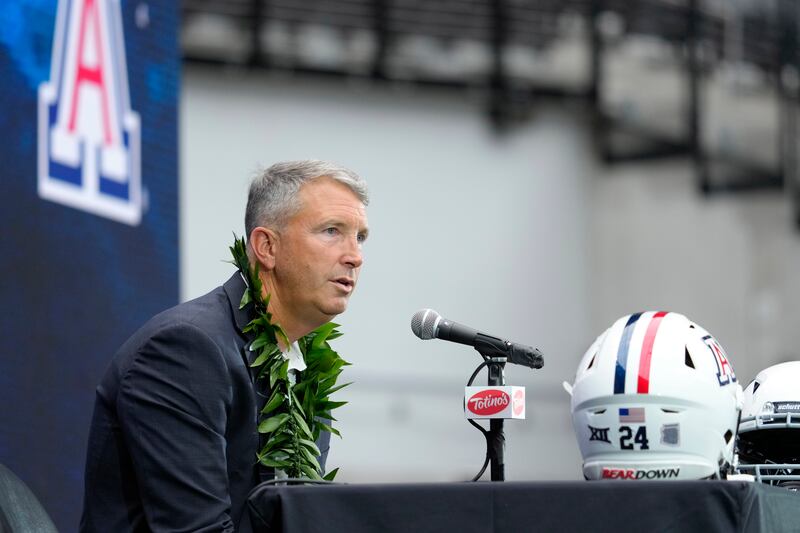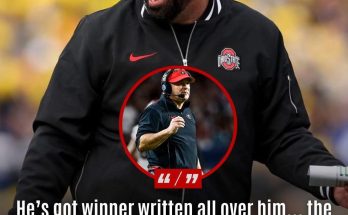When Brent Brennan took over as the head coach of the Arizona Wildcats football program, expectations were tempered but hopeful. Coming off years of inconsistency and underperformance, the Wildcats were desperate for a fresh vision and an injection of competitive energy. Brennan, known for his program-building prowess and steady leadership, brought with him a culture of accountability and internal competition — especially among his coaching staff.
Now, just months into his tenure, Brennan is crediting a unique dynamic within his staff as a key reason why Arizona football is on an upward trajectory: coordinator competition.
While most programs rely heavily on one or two key figures calling the shots on each side of the ball, Brennan has encouraged a more dynamic approach, where both offensive and defensive coordinators are constantly being pushed by their peers — and by each other — to innovate, adapt, and outperform. It’s a move that’s creating an edge in Tucson that Brennan believes is contagious.
Building a Collaborative Yet Competitive Culture
From the outset, Brennan set the tone by selecting coordinators who were not only capable in their respective domains but also had complementary skill sets and track records of success.
Duane Akina, brought in as defensive coordinator, is a defensive mastermind with deep Pac-12 ties and decades of experience under his belt. Known for developing elite secondaries and producing NFL talent, Akina brings a cerebral approach to the game.
On the offensive side, Danny Langsdorf was tabbed as Brennan’s pick to lead the Wildcats’ attack. A seasoned veteran with stops at Nebraska, Oregon State, and Colorado, Langsdorf brings a pro-style pedigree but with a willingness to adapt to modern tempo and spread concepts.
Brennan didn’t just hire them to lead their units. He hired them to compete, to challenge each other, and to foster a climate where iron sharpens iron.
“We’re not here to rest on reputations,” Brennan said during spring practice. “Every day we’re asking, ‘How do we get better?’ And that starts in our staff rooms. I want Duane challenging Danny. I want Danny pushing our special teams coordinator. We’re setting the tone by being hungry at the top.”
That internal competition is already paying dividends.
Defensive Aggression Redefined
Arizona’s defense has long been a liability in the Pac-12. But under Akina, the Wildcats are making significant strides. With Brennan pushing for more versatility and takeaways, Akina has been aggressive in implementing a hybrid scheme that maximizes the team’s speed and length.
Players like Jacob Manu, an explosive linebacker who emerged last season, have become cornerstones in Akina’s system. The Wildcats are utilizing more multiple fronts, disguising coverages, and leaning on aggressive blitz packages.
“Coach Akina is all about being disruptive,” said junior defensive back Treydan Stukes. “We’re not sitting back. We’re coming after teams. And we’re communicating better than ever.”
Akina’s approach has also been shaped by the pressure of keeping up with Langsdorf’s offense in practice. If the defense gets torched one day, it becomes a badge of pride to flip the script the next.
“That back and forth is what makes us better,” Akina said. “If we’re too comfortable, we’re not growing. Danny’s gonna try to expose us. And we’re going to make life hell for him too.”
Offense Built on Tempo, Toughness, and Versatility
Langsdorf, meanwhile, has taken full advantage of Brennan’s openness to experimentation. While Arizona had offensive success last season, Langsdorf is focused on blending tempo with structure, utilizing the full width of the field and taking calculated deep shots.
Redshirt freshman quarterback Brayden Dorman has been impressive during spring ball, showing growth in decision-making and mechanics. Paired with a deep running back room and a healthy wide receiver corps led by Kevin Green Jr., the Wildcats’ offense is looking fast, efficient, and deceptively physical.
Langsdorf’s unit also mirrors Brennan’s cultural emphasis on toughness.
“Coach Brennan’s message is clear: we’re not trying to be finesse. We’re going to punch teams in the mouth,” Langsdorf said. “That’s what we preach every day.”
Having to scheme against Akina’s exotic defenses has forced Langsdorf and the offensive staff to get creative — and to prepare for real-game pressure in every practice rep.
“They throw looks at us that most teams won’t,” Dorman said. “So we’re getting way more comfortable seeing pressure, reading disguises, and adjusting at the line.”
Brennan’s Blueprint: Competition from Top to Bottom
What’s clear is that Brennan has created a philosophical trickle-down effect. Coordinator competition is the tip of the spear in a program-wide mindset shift. Position coaches are now in friendly battles over unit efficiency. Players see that drive from their coaches and emulate it.
“We see Coach Akina talking trash to Coach Langsdorf after a good day,” laughed linebacker Leviticus Su’a. “It’s all love, but it fires everyone up.”
Brennan has also instituted internal metrics — like weekly “unit champions” and “staff MVPs” — that are calculated from practice film and team analytics. While these don’t affect depth charts, they build a sense of achievement and spark camaraderie.
“We want every coach and every player walking into this building knowing they have something to prove,” Brennan said. “Complacency is the enemy of growth.”
The Bigger Picture: Arizona’s Identity is Taking Shape
Under Brennan’s watch, the Arizona Wildcats are starting to forge a new identity — one based on resilience, internal competition, and strategic adaptability.
That’s critical in a Pac-12 landscape (soon to become part of the Big 12) that is more competitive than ever. Arizona will be joining a conference that includes powerhouses like Utah, Kansas State, and TCU. Brennan knows that to compete, his team needs more than just talent — it needs an edge.
“It’s not about being flashy,” Brennan said. “It’s about being ready when the fourth quarter hits and everything’s on the line.”
If Arizona can channel the fire being built in their coaching rooms into gameday execution, they may not just be competitive — they could be dangerous.
Recruiting Impact
The renewed sense of purpose and the visible energy on the field has begun resonating with recruits as well. Arizona’s spring recruiting visits have been described as “electric” by high school coaches and analysts alike.
The Wildcats have already secured early commitments from two key four-star prospects, both of whom cited the coaching staff’s enthusiasm and the “energy of practice” as deciding factors.
“I watched how the coaches interacted with each other, and you could tell they were locked in,” said 2025 WR commit Jalen Thomas. “It wasn’t fake. They were coaching hard, competing, and having fun.”
That vibe has helped Arizona differentiate itself from programs that might be more polished but less authentic.
Areas for Growth
Despite the progress, Brennan knows there’s work to do.
The offensive line remains a unit that must grow in cohesion and physicality. Defensively, the secondary still needs to improve its consistency, especially in late-game situations. Brennan also wants to see more situational awareness across the board — particularly in two-minute drills and red zone execution.
But what gives him confidence is the willingness of his coordinators and staff to self-critique and elevate.
“Nobody’s pointing fingers in this building,” Brennan said. “We hold ourselves accountable, and it starts with me. If I don’t bring it every day, how can I expect the staff to? And if the staff doesn’t bring it, the players won’t either.”
Final Word: A New Era is Brewing in Tucson
Arizona football may still be in a rebuild, but under Brent Brennan, the Wildcats are building the right way. His strategy of fostering healthy competition among his coordinators is more than just a gimmick — it’s a cultural shift.
The result? A program where ideas are constantly tested, weaknesses are exposed and addressed, and the drive to improve is relentless.
“We’re not perfect,” Brennan concluded, “but we’re moving. We’re climbing. And I believe we’ve got something special brewing.”
As the 2025 season draws near, one thing is clear: Brent Brennan has Arizona believing again. And if the coordinator competition continues to spark innovation and accountability, the Wildcats may soon find themselves roaring louder than they have in decades.



